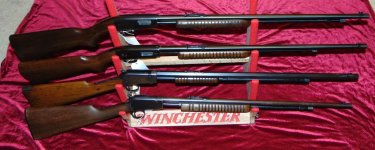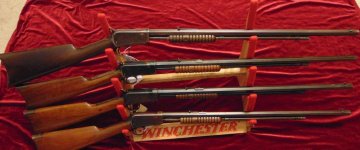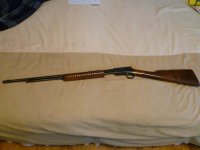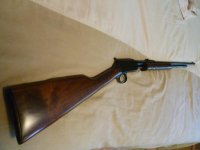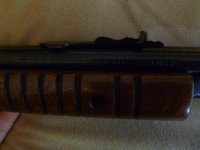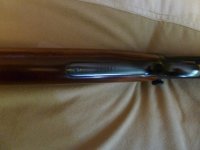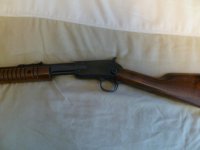The 62A is the slightly redesigned Model 60.
The biggest difference is inside. The Orig Model 60 used the old style flat mainspring that it's previous Models (18)90 and 1906 used.
The Model 62A uses a coil mainspring and the necessary linkage for it to operate.
There are a few changes in the bolt, firing pin, ect as well from the earlier models.
Some early production Model 62A (started in 1940) used old left over production Model 62 barrels already roll marked.
So the Model as read off of the barrel will be a Model 62,,but the actual Model from the Ser#, mfg date and the mechanics of the rifle are a Model 62A.
I think they stop making these in '58 or '59.
The 62A used a slightly heavier butt stock and larger forend than the earlier rifles,,more adult sized.
Plastic butt plate, same as used on most all of their .22's
Cal .22 s,l & lr,,,and some in .22short only.
Some of the .22short only rifles made a 'gallery guns' having the triangular shaped loading port for use with the gallery quick loading tube.
Those with the heavy roll mark 'Winchester' / trademark on the left side of the frame (often then filled with red) was an extra from the factory but many gallery guns were so marked as they were purchased in quantity. So the marking was graciously applied by Win and it was free adv as well for them.
(Lots of fake gallery guns, upgraded Deluxe guns and just plain NIB 62 and 62A Winchesters around these days. Complete with a box and papers.
They just can't help themselves when there's hudge profits to be had.)
Though the 62/62A may appear to be in fine opperating order, it would do well to run a few dummy rds through the action,,or live rounds if doable.
Sometimes the actions will fail to feed out of the magazine.
Other times fail to extract the last round from the chamber and eject it from the gun, instead leaving it back in the carrier.
A weak magazine spring or stalled mag follower is usually the cause here.
A broken carrier spring is not uncommon but a cheap fix and a good bargining point for a reduced price.
Check the bore very carefully for bulges or ringed bore. .22's especially older ones are prone to them
Run your finges slowly up and down the outside feeling for the bulged area. A tight cleaning patch slowly down and back out of the bore will usually find a ring or 'free spot' in the bore.
Check the half cock notch for hold,,it's your 'Safety'
Ser# on the lower should match that on the upper unit. Not unusual to find mix-matched halves.
They usually work fine, but no use paying for a matching rifle when it's not.
Take a close look at the magazine tube rings and how they are attached to the underside of the bbl.
They should be secure with no looseness at all AND show no signs of hammering or punch marks around them or the bbl area.
The latter from attempts to either remove them or later tighten them up,,all from improper method of removal.
The rings rotate into their dovetails cut in the bbl,,they do not slide cross-wise into the dovetail as a common front or rear sight does.
Trying to remove them by hammering them out of the rotory dovetail pocket in the bbl simply batters the bbl and the ring.
You often see the damaged ring and bbl socket repaired with solder, epoxy and even a spot of weld to then hold things together.
Yes the whole thing can be taken apart and made good again, but not without some work and $$.
$900 for me for a 62A would need to be close to 90% condition overall rifle with no problems to the mechanics and a bright shiney bore.
Not just a shooter condition rifle.

